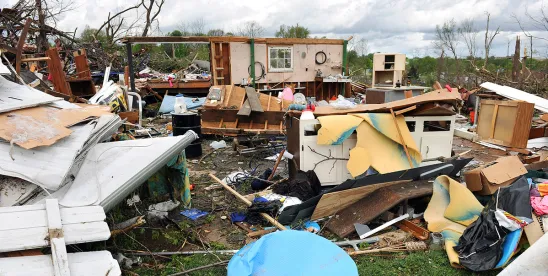A hurricane, natural disaster, or any other crisis in the workplace can bring a business to a screeching halt and devastate the lives of a business’s most valuable asset — its employees.
To minimize the impact of a natural disaster, companies should have various plans in place before disaster strikes, such as a crisis management plan, a communications plan, and a disaster response and recovery plan. These plans must take into account the effect a catastrophe may have on workers and include ways to help impacted employees return to work as soon as practical to ensure continued productivity of the workplace even in the face of personal loss. Any enacted plan should also consider the application of relevant federal and state laws to ensure compliance and avoid any employment-related lawsuits or any agency enforcement actions following a natural disaster.
Determine individual crisis management responsibilities. Employers should identify those employees who are essential to each business function, determine whether they will be needed on-site in the days preceding and following a natural disaster, and develop a plan. Once a plan has been established, the next step is to meet with key employees to communicate and identify areas of accountability and responsibility and how each employee should perform his or her emergency-response duties effectively.
Communicate with employees. Employers should communicate their disaster plans to all employees before, during, and after a disaster event to clarify expectations and ensure everyone understands their respective roles and responsibilities. In the days leading up to a hurricane or other predictable natural disaster, all employees should know the appropriate channels of communication for when disaster strikes, such as the company’s social media pages, website, or internal communication system. Such efforts will ensure consistent and effective communication with employees, leaving no question as to their understanding of the situation or the roles and duties expected of each.
Train managers and supervisors on how to manage employees coping with the effects of a workplace crisis. When a disaster strikes, managers and supervisors are the people who deal directly with employees. It is important to educate managers and supervisors ahead of time about the possible effects of a crisis or disaster on employees and how to spot indicators of emotional or behavioral conditions that may need attention. You may need to hire a consultant to meet with your managers and supervisors, or you might take advantage of free resources and services provided by government agencies or private relief organizations. At a minimum, managers and supervisors should know to refer affected employees to an employee assistance program or human resources department for the identification of other sources of professional assistance.
Prepare employees and managers for remote work. As we all learned during the COVID-19 pandemic, our typical in-office work lives can be uprooted in a matter of days when a disaster looms. Employers whose employees may work remotely for extended periods of time should revisit their remote work policies and ensure that they remain consistent with business needs. With any natural disaster, there is a chance that the workplace may not be operable for some period of time — yet work will remain to be done. Talk with management about how employees may be able to transition on a moment’s notice to remote work, and ensure that before disaster strikes employees have the tools necessary to do so.
Be familiar with federal, state, and local laws. Employers should be cognizant of the federal, state, and local laws that can be enacted during and after a natural disaster. These laws can shape your workplace policies surrounding your disaster planning and recovery efforts. Some laws you should be familiar with include the Fair Labor Standards Act, the Family and Medical Leave Act, the Americans with Disabilities Act, the Worker Adjustment and Retraining Notification Act, the Uniformed Services Employment and Reemployment Rights Act, the National Labor Relations Act, and the Occupational Safety and Health Act and related OSHA regulations.
Finally, cut employees some slack. Employers should treat employees fairly and with compassion when it comes to getting things back on track. Revisit leave policies and benefits to determine whether the nature of the crisis warrants a modification of the benefits provided or extended leave, even if only temporarily until the crisis passes. Keep in mind, though, that all policies should be applied uniformly, whether modified or not.
The bottom line for employers is to plan ahead and not wait until disaster strikes. Having a well-written emergency response plan and clear employment policies is key to protecting employees and the employer, minimizing confusion during and after an emergency, and helping ensure that operations are restored as quickly as possible following any emergency-related shutdowns.





 />i
/>i

